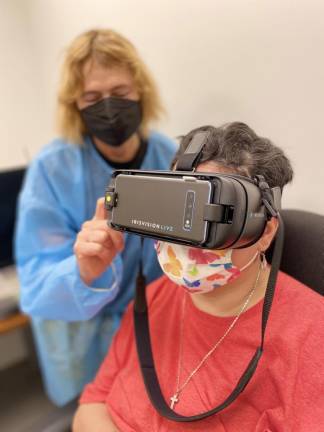OT Can Help People With Visual Impairments
How occupational therapy can help people function in all their environments

Occupational therapy, commonly called OT, is a form of therapy for people with temporary or permanent disabilities that uses rehabilitation to restore or improve skills necessary for everyday activities.
These activities include selfcare, work, leisure, care for family and community engagement. From basic tasks, such as brushing teeth, combing hair and counting money, to more complex tasks such as utilizing smart phones and computers, the goal of OT is to help people function to their fullest abilities in all their environments – at home, work, school and in the community.
Occupational therapy focuses on treating not only the physical, but also the emotional, cognitive and social aspects of a person’s well-being through engagement in meaningful activity. People with any kind of physical, cognitive or emotional disability can benefit. Occupational therapists use a variety of approaches to help people to recover or maximize functioning and gain independence.
OT treatment sessions require creativity and collaboration with a client, and the approaches are unique to each client’s individual abilities, needs, interests and life preferences.
Occupational therapy plays an important role in helping people with visual impairments. People with visual loss can be missing a part of the world around them, and occupational therapy can teach them new strategies to help to compensate for what they have lost.
Using rehabilitation techniques, OT can help people with eye diseases, such as macular degeneration, glaucoma, diabetic retinopathy and genetic conditions, such as retinitis pigmentosa.
Techniques include education on safety during daily activities and setting up modifications of home environments, as well as evaluation and training on the use of low vision devices or aids — magnifiers, lighting and electronic magnification, voiceover and other technological devices.
Occupational therapy also teaches strategies to compensate for loss of visual field, depth perception, increased glare and decreased contrast and color sensitivity. For example, appropriate lighting can help people with visual impairments see food on their plate and a magnifying device can allow them to write a check again.
Learning new visual skills such as visual fixation, visual pursuit, tracking, conversion, diversion and visual motor integration can reopen the world for people with visual impairments.
Scanning and tracking with emphasis on head movement, for instance, can help people with glaucoma or retinitis pigmentosa compensate for loss of peripheral visual field. Eccentric viewing training can help people with macular degeneration learn how to look around blind spots of their central vision.
Lighthouse Guild provides occupational therapy services for people with visual impairments. Services include training on the latest assistive technologies, such as IrisVision, OrCam and eSight and assistance with learning accessibility features and functions of smartphones and other electronic devices.
Occupational therapists must have a master’s degree in occupational therapy from an accredited university program, be certified by the National Board for Certification in Occupational Therapy (NBCOT) and hold a professional license in the state where they practice.
For more information on Occupational Therapy, one may contact American Occupational Therapy Association, https://www.aota.org/%20About-Occupational-Therapy/Patients-Clients.aspx and New York State OT association, https://www.nysota.org/page/ConsInf
Inna Babaeva, OTR/L, PhD, is an Occupational Therapist Registered/Licensed at Lighthouse Guild. Reprinted with permission from Able News.